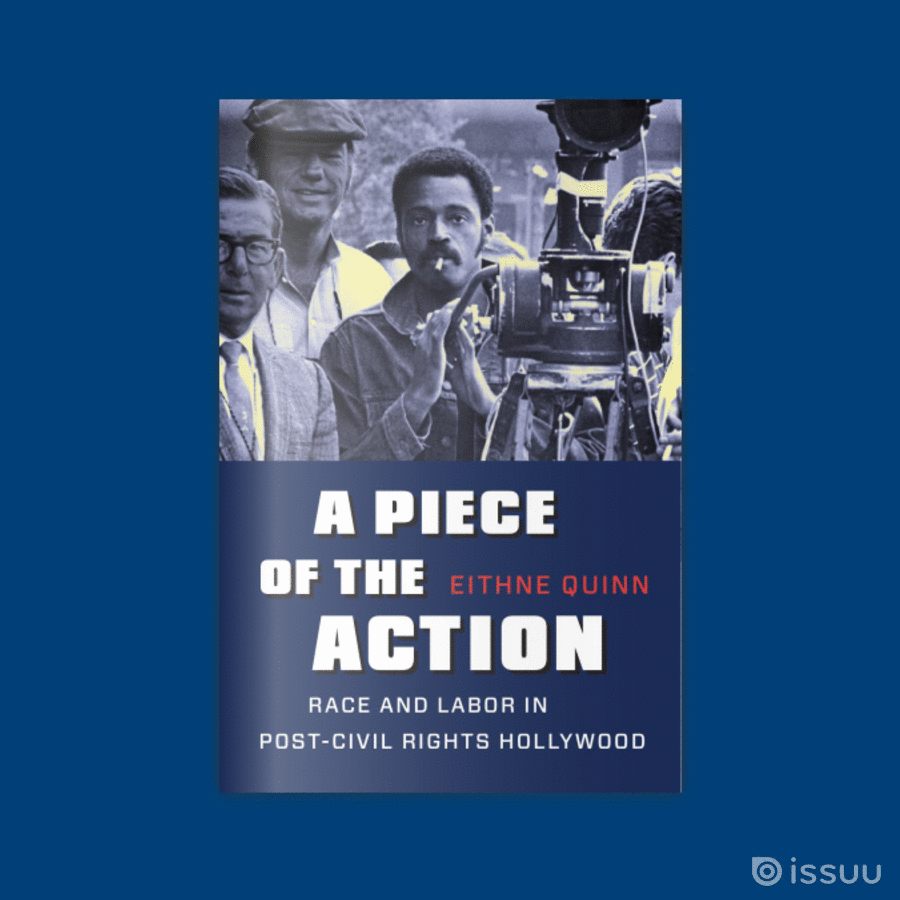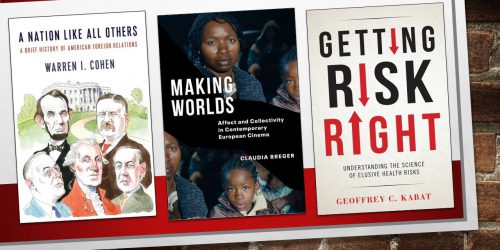Continue Your Exploration of New Books in Film Studies with Philip Leventhal

Yesterday, I talked about some new books from our Film and Culture series. I did not want to overwhelm you with too much information, so here are four more books we recently published in film studies that I am also very excited about.
 As with the titles in the Film and Culture series, these books span a wide variety of topics, from early depictions of Christ to Hollywood’s failure to integrate its workforce in the Civil Rights era. I’ll begin with Claudia Breger’s new book, Making Worlds: Affect and Collectivity in Contemporary European Cinema. This is a book that could not be more timely: it examines how major European directors are imagining new forms of community in an age of nationalist populism. It’s a book that brilliantly mixes theory (Deleuze, Rancière, and Latour) with readings of films by Haneke, Iñárritu, Kaurismaki, and others. (For more from Claudia, check out her short interview from earlier today.)
As with the titles in the Film and Culture series, these books span a wide variety of topics, from early depictions of Christ to Hollywood’s failure to integrate its workforce in the Civil Rights era. I’ll begin with Claudia Breger’s new book, Making Worlds: Affect and Collectivity in Contemporary European Cinema. This is a book that could not be more timely: it examines how major European directors are imagining new forms of community in an age of nationalist populism. It’s a book that brilliantly mixes theory (Deleuze, Rancière, and Latour) with readings of films by Haneke, Iñárritu, Kaurismaki, and others. (For more from Claudia, check out her short interview from earlier today.)

 I am interested in expanding our list in African American film studies and history, so I am particularly glad that Eithne Quinn’s A Piece of the Action: Race and Labor in Post-Civil Rights Hollywood is now available. Much as Hunter Vaughan’s recent book Hollywood’s Dirtiest Secret takes on the myth of the film industry’s progressive attitudes toward the environment, A Piece of the Action does the same for Hollywood’s supposed liberal attitudes toward race. Quinn exposes the industry’s unwillingness to integrate its film crews. At the same time, she considers how films like In the Heat of the Night, Sweet Sweetback’s Baadasssss Song, Super Fly, Claudine, and Blue Collar examined, in different ways, questions of Black labor. (And for a musical interlude, here is the opening credits for Superfly: )
I am interested in expanding our list in African American film studies and history, so I am particularly glad that Eithne Quinn’s A Piece of the Action: Race and Labor in Post-Civil Rights Hollywood is now available. Much as Hunter Vaughan’s recent book Hollywood’s Dirtiest Secret takes on the myth of the film industry’s progressive attitudes toward the environment, A Piece of the Action does the same for Hollywood’s supposed liberal attitudes toward race. Quinn exposes the industry’s unwillingness to integrate its film crews. At the same time, she considers how films like In the Heat of the Night, Sweet Sweetback’s Baadasssss Song, Super Fly, Claudine, and Blue Collar examined, in different ways, questions of Black labor. (And for a musical interlude, here is the opening credits for Superfly: )
 From a much earlier period in the history of film is Phillip Maciak’s The Disappearing Christ: Secularism in the Silent Era. While we tend to think of the birth of cinema as a harbinger of modernity, it turns out that one of the most popular narratives in early film was the very old story of Christ. Phil shows how Christ became a powerful vehicle for Americans to navigate a rapidly modernizing society. Needless to say, one of the films that Phil discusses at great length is the 1925 version of Ben-Hur. Here’s the trailer:
From a much earlier period in the history of film is Phillip Maciak’s The Disappearing Christ: Secularism in the Silent Era. While we tend to think of the birth of cinema as a harbinger of modernity, it turns out that one of the most popular narratives in early film was the very old story of Christ. Phil shows how Christ became a powerful vehicle for Americans to navigate a rapidly modernizing society. Needless to say, one of the films that Phil discusses at great length is the 1925 version of Ben-Hur. Here’s the trailer:
 Finally, are you looking for straightforward overview of the history of Japanese cinema? Well, Yomota Inuhiko’s What Is Japanese Cinema? is probably not the book for you. However, if you are looking for a concise, lively, refrishingly opinionated, and somewhat idiosyncratic take on Japanese film from Godzila and pornography to the films of canonical directors such as Kurosawa, Ozu, Suzuki, and Miyazaki, this is the book for you. A great book for courses on Japanese film or for the serious fan. We all have our favorites among Japanese films and directors, and Yomota covers many of them, including one of mine, Seijun Suzuki. Here’s the trailer to Branded to Kill (1967):
Finally, are you looking for straightforward overview of the history of Japanese cinema? Well, Yomota Inuhiko’s What Is Japanese Cinema? is probably not the book for you. However, if you are looking for a concise, lively, refrishingly opinionated, and somewhat idiosyncratic take on Japanese film from Godzila and pornography to the films of canonical directors such as Kurosawa, Ozu, Suzuki, and Miyazaki, this is the book for you. A great book for courses on Japanese film or for the serious fan. We all have our favorites among Japanese films and directors, and Yomota covers many of them, including one of mine, Seijun Suzuki. Here’s the trailer to Branded to Kill (1967):
Enter our SCMS 2020 drawing for a chance to win a free book. Although we encourage you to buy from your local bookstores, we are offering a 30 percent conference discount when you order from our website. Use coupon code SCMS20 at checkout to save on our SCMS books on display.








